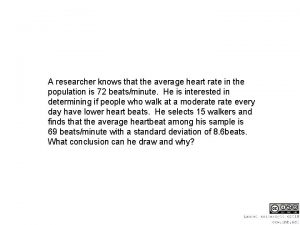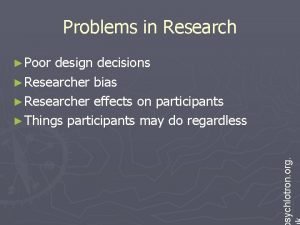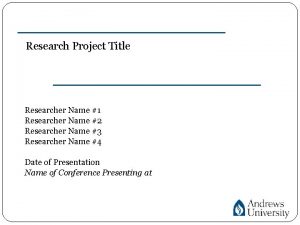Topic Research Design Introduction Any researcher who wants



















- Slides: 19

Topic: Research Design Introduction: Any researcher who wants to investigate a research question or test a hypothesis faces some important problems that must be solved before he/she can start his research or study. These are the problems: 1. Which research strategy should be used? 2. What kind of data will be needed to investigate the research questions? 3. How will the data be analyzed? The research design is the blueprint that enables the researcher to come up with solutions to these problems and guides him/her in the various stages of his/her research.

Topic: Research Design Sub-topic: Types of Research Design 1. 2. 3. The Experimental Design How is it done? Or the steps. Hypothesis: Training improves employee productivity. 4. Step 1: Divide your subjects into two groups: the experimental (treatment) group and the control or comparison group. 5. Step 2: Measure the groups on the dependent variable. In other words, we measure each group’s productivity.

Topic: Research Design Step 3: We give the treatment (training) to the experimental group. The control group gets no treatment or training. Step 4: We measure the two groups on the dependent variable. In other words, we measure their productivity again. Conclusion: If productivity of the experimental group increases after the treatment, we can then conclude that the treatment or training improves workers’ productivity.

Topic: Research Designs Sub-topic: Types of Research Design Hypothesis: Giving commission to employees improves their performance. Step 1: Divide subjects into two groups: Experimental and control groups. Step 2: Measuring the two groups on the dependent variable Group Performance Before Treatment Experimental 50 percent Control 50 percent Step 3: Give commission to the experimental group. The control group gets no commission. Step 4: Measuring the two groups on the dependent variable Group Performance After Treatment Experimental 70 percent Control 50 percent Results and Conclusion: The performance of the experimental group increases with commission. Therefore, commission improves employee performance.

Topic: Research Designs Sub-topic: Types of Research Design 1. Experimental Design: Evaluation of the Experimental Design: • Does it have internal validity? Internal validity is the most important type of validity. It talks about causal relations. In other words, it tells us whether or not the independent variable (IV) causes changes in the dependent variable (DV). This is the purpose of any experiment.

Topic: Research Designs Sub-topic: Types of Research Design Answer: It will have internal validity if a. We use randomization to select members for both the experimental group and control group. When use randomization, we make sure that every member of a population has an equal chance of being selected for the group. The purpose of randomization is to equalize the two groups. b. We eliminate threats to internal validity: (i) Maturation: This means that people change overtime. If your experiment takes time (such as a year), the members of the experimental group and the control group may change, and this change may affect the dependent variable in your experiment.

Topic: Research Design Example: This is example shows the effect of maturation on the dependent variable. We want to see if piece rate pay (IV) increases workers’ productivity (DV). Suppose that this experiment is done for one year. After one year, we will not be sure whether any increase in productivity is due to the introduction of piece rate pay or to the fact that the workers have become mature in doing their jobs. How do get rid of maturation? Answer: we have to use a control group.

Topic: Research Design Sub-topic: Types of Research Design (ii) Mortality: This means that some members of the experimental and/or control group drop out of the experiment for some reason.

Topic: Research Design Sub-topic: Types of Research Design 1. Experimental Research Design Ethical Issues: • • • In experiments, subjects need to be debriefed. Debriefing means that we (i. e. , the researchers who do the experiments) are obliged to inform the subjects about the purpose of the experiment, that the information that they give you will be confidential, and that they will not be deceived (i. e. , the information will be used only for research and not for any other purpose). Debriefing is usually done immediately after the experiment. What is debriefing in experimental research?

Topic: Research Design Sub-topic: Types of Research Design 2. Cross-Sectional Design Characteristics: a. It involves more than one case. Usually, we study many cases. For example, we study 60 countries to see whethere is a link between democracy and economic development. We need those many cases to see if there is variation. For example, if democracy is at the same in all 60 countries, then there is no variation. Hence, we cannot study those cases. This means that we need variation (i. e. , differences) on a variable such as democracy in order to study it.

Topic: Research Design Sub-topic: Types of Research Design Country Dem Econ Dev Sudan 60 50 Syria 70 60 Lebanon 80 65 UAE 80 70 Iran 87 75 This is data for a cross-sectional study. Here, we have 5 cases which are the countries. We also have enough variation. The more cases you have, the more the variation there will be.

Topic: Research Design Sub-topic: Types of Research Design b) All the cases represent events happening at one point of time such as a specific year like 2005. Example: Data on Dem and Economic Dev for 5 countries for 2005. _________________________ __ Country Dem Econ Dev Sudan 60 50 Syria 70 60 Lebanon 80 65 UAE 80 70 Iran 87 75 _________________________

Topic: Research Design Sub-topic: Types of Research Design c) When we do cross-sectional studies, we are not seeking causation or causal relationships. We are just looking for association or correlation or link. From crosssectional designs, we get correlation, but from experimental designs we get causation because in experimental design we have control over the experimental conditions.

Topic: Research Design Sub-topic: Types of Research Design Evaluation of Cross-sectional Design: a) It is likely to be strong on external validity or generalizability. This is likely to be the case if the cases involved in a cross-sectional study are many. This means that the more cases you have a cross-sectional the stronger will be external validity. So if you have two studies one with 15 cases and the other with 200 cases, the latter will have stronger external validity. b) The Cross-sectional design is not strong on internal validity or causality, because we do not control for factors that could affect the dependent variable.

Topic: Research Design Sub-topic: Types of Research Design Exercise Question: Contrast between experimental design and crosssectional design? To answer this question, we have to discuss the differences between the two designs. The following are the differences: a. In cross-sectional designs, we do not have experiments whereas we have these things in experimental designs b. Experimental designs are very strong on internal validity while cross-sectional designs are weak on internal validity.

Topic: Research Design Sub-topic: Types of Research Design 3. Longitudinal Research Designs Characteristics: a. Here the time dimension or element is important b. We collect data for events which happened at two points of time at least Example: Suppose that I am studying the extent to which the introduction of TQM improves productivity in some business organization. Suppose further that TQM was introduced in that organization in 2000. To answer this question, I have to collect data on productivity in 2000 when TQM was introduced and also collect data on productivity after TQM was introduced (e. g. , in 2006).

Topic: Research Design Sub-topic: Types of Research Design Example: Suppose I am studying the effect of inflation on business profitability in KFC. We could use a longitudinal research design here. My data may look like this: Year Inflation Profitability 2000 10 50 2001 13 70 2002 15 80 2003 20 100 2004 22 240

Topic: Research Design Sub-topic: Types of Research Design C. Variation is established by collecting data for events happening at two points of time at least. Variation here means differences in the values of variables. If there is no variation, then we cannot do studies. Variation in the values of our variables is needed in all research designs. Remember: No variation, no research.

Topic: Research Design Sub-topic: Types of Research Design Evaluation of the Longitudinal Research Design: a. It is a little strong on internal validity or causality. It is stronger than cross-sectional research design on internal validity. However, it is not strong as experimental design. Experimental design is much stronger on internal validity than longitudinal design, why? Answer: In experimental designs, we have control over experiment. We do not have this kind of control in longitudinal design. b. In longitudinal designs, we attempt to control for external factors by using data analysis techniques such as regression analysis.
 Research impact and researcher identity
Research impact and researcher identity John 14:1-3
John 14:1-3 Lead paragraph example
Lead paragraph example Narrow
Narrow Some any cheese
Some any cheese Any to any connectivity
Any to any connectivity Pertanyaan terbuka
Pertanyaan terbuka Preference for specific design control for procedural bias.
Preference for specific design control for procedural bias. Probability vs non probability sampling
Probability vs non probability sampling Extent of researcher interference
Extent of researcher interference Learning competency with code
Learning competency with code Think like a researcher
Think like a researcher Ibigay ang limang katangian ng mananaliksik
Ibigay ang limang katangian ng mananaliksik American researcher who involved in getting heart rate
American researcher who involved in getting heart rate What are the habits of a good researcher
What are the habits of a good researcher Thinking like a researcher
Thinking like a researcher Extent of researcher interference
Extent of researcher interference A researcher claims that the average wind speed
A researcher claims that the average wind speed Active researcher
Active researcher Individual interview in research
Individual interview in research





































